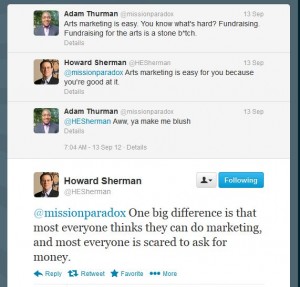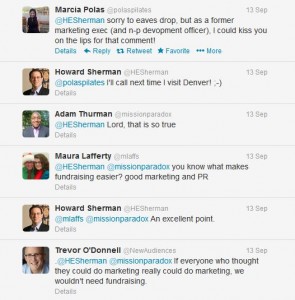I was thinking last week about the growing sentiment that non-profit organizations should resist the impulse to do “more with less.” The idea being that it gives funders, boards, government entities and the public an unrealistic view of what the real costs of programs actually are and is likely to cause burnout among employees.
The quality of all programs will probably suffer in an effort to make up for the loss of funding to one, as well.
Although it would really hurt organizational pride and morale, the suggestion is to eliminate the program rather than stretching and stressing yourself even more trying to maintain it. That way, at least the consequences of low funding are unambiguous.
A cynical thought crept into my mind that some organization of younger workers unfettered by concerns of good pay and work-life balance might come along and belie your insistence that the program couldn’t be supported, by happily suffering through its execution.
But soon I got to thinking, why not let them? Not that you should welcome an under-captialized organization with unrealistic expectations, but if there was someone qualified who thought they could do a better job, maybe your organization should hand over your files to them.
I started to wonder if many non-profits had really ever thought of this. Most organizations are aware of people doing similar work in their region, whether they are viewed as competitors or providing parallel services. If you are being faced with having to eliminate a program, but are conflicted and a little guilty thinking about all those whom you serve losing something they valued, perhaps it is best to give your program materials to a group that possesses better resources or sees that program as one of their core competencies.
Once you no longer view each other as competitors, there may be room for constructive partnerships. For example, a performance venue who is seeing their K12 school show program flounder due to decreasing availability of bus money might direct their clients to a group that performs in schools, but doesn’t have their own facility.
The traveling group may benefit from the additional contact list, as well as costumes and props that the venue will no longer be using. In return, however, the traveling group may still do an occasional school show for the venue or may produce a series of weekend family matinees at the venue, allowing the venue to continue offering family programming without having to bankroll the development.
Or perhaps both groups wanted to do an after school program, but neither had all the resources they needed to pull it off. Yet as partners, they do.
By the end of my musing, I started to think that trying to do more with less and hold on all your programs might not only be harmful to your organization, it might also impede constructive partnerships.
Instead of looking around at other groups as competitors for the same pie, which granted is increasingly becoming the case, it may be more productive to evaluate what other people are doing as well, if not better than you, with an eye to possibly having to cede that to them.
Times when things are going well are probably best to consider these issues because it also allows the time to evaluate potential partnership options while free of financial panic.
Perhaps you will decide to transition things away before a critical decision ever needs to be made, when your program still remains vibrant and is a worthwhile addition to another company.
No organization should be in a mode of constantly contemplating its demise. I know many elderly start mentally ear marking who will get what when they die, if they haven’t already started actively giving things away. I don’t think that is a healthy way for a non-profit to operate.
It should know where its strengths lay, what its core functions are and what things occupy a more secondary role. Strive for excellence in everything and shine in the community, but be consistently clear about what the priorities of the organization are.
Boards and staff members are likely to have strong emotional attachments to the work that your organization is doing, and probably rightfully so. An open and ongoing conversation about what another organization is doing well can help to motivate your organization to step their game up and do a little better.
But having an open conversation about the organizational priorities as well as what other organizations are doing well may ease the decision to cede/transition a program away if the staff and board has regularly acknowledged the worthiness of another organization to do the work that is being set aside.




I've been to a few of the Science on Tap events, though I never gave a talk at one of…